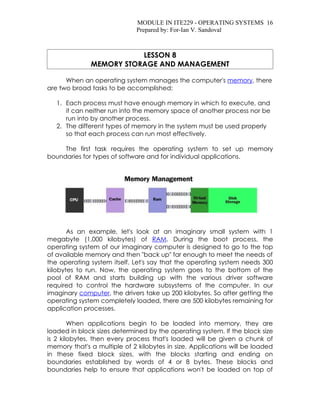
Lesson 8 Memory Storage And Management
- 1. MODULE IN ITE229 - OPERATING SYSTEMS 16 Prepared by: For-Ian V. Sandoval LESSON 8 MEMORY STORAGE AND MANAGEMENT When an operating system manages the computer's memory, there are two broad tasks to be accomplished: 1. Each process must have enough memory in which to execute, and it can neither run into the memory space of another process nor be run into by another process. 2. The different types of memory in the system must be used properly so that each process can run most effectively. The first task requires the operating system to set up memory boundaries for types of software and for individual applications. As an example, let's look at an imaginary small system with 1 megabyte (1,000 kilobytes) of RAM. During the boot process, the operating system of our imaginary computer is designed to go to the top of available memory and then "back up" far enough to meet the needs of the operating system itself. Let's say that the operating system needs 300 kilobytes to run. Now, the operating system goes to the bottom of the pool of RAM and starts building up with the various driver software required to control the hardware subsystems of the computer. In our imaginary computer, the drivers take up 200 kilobytes. So after getting the operating system completely loaded, there are 500 kilobytes remaining for application processes. When applications begin to be loaded into memory, they are loaded in block sizes determined by the operating system. If the block size is 2 kilobytes, then every process that's loaded will be given a chunk of memory that's a multiple of 2 kilobytes in size. Applications will be loaded in these fixed block sizes, with the blocks starting and ending on boundaries established by words of 4 or 8 bytes. These blocks and boundaries help to ensure that applications won't be loaded on top of
- 2. MODULE IN ITE229 - OPERATING SYSTEMS 17 Prepared by: For-Ian V. Sandoval one another's space by a poorly calculated bit or two. With that ensured, the larger question is what to do when the 500-kilobyte application space is filled. In most computers, it's possible to add memory beyond the original capacity. For example, you might expand RAM from 1 to 2 gigabytes. This works fine, but can be relatively expensive. It also ignores a fundamental fact of computing -- most of the information that an application stores in memory is not being used at any given moment. A processor can only access memory one location at a time, so the vast majority of RAM is unused at any moment. Since disk space is cheap compared to RAM, then moving information in RAM to hard disk can greatly expand RAM space at no cost. This technique is called virtual memory management. Disk storage is only one of the memory types that must be managed by the operating system, and it's also the slowest. Ranked in order of speed, the types of memory in a computer system are: • High-speed cache -- This is fast, relatively small amounts of memory that are available to the CPU through the fastest connections. Cache controllers predict which pieces of data the CPU will need next and pull it from main memory into high-speed cache to speed up system performance. • Main memory -- This is the RAM that you see measured in megabytes when you buy a computer. • Secondary memory -- This is most often some sort of rotating magnetic storage that keeps applications and data available to be used, and serves as virtual RAM under the control of the operating system. The operating system must balance the needs of the various processes with the availability of the different types of memory, moving data in blocks (called pages) between available memory as the schedule of processes dictates.
